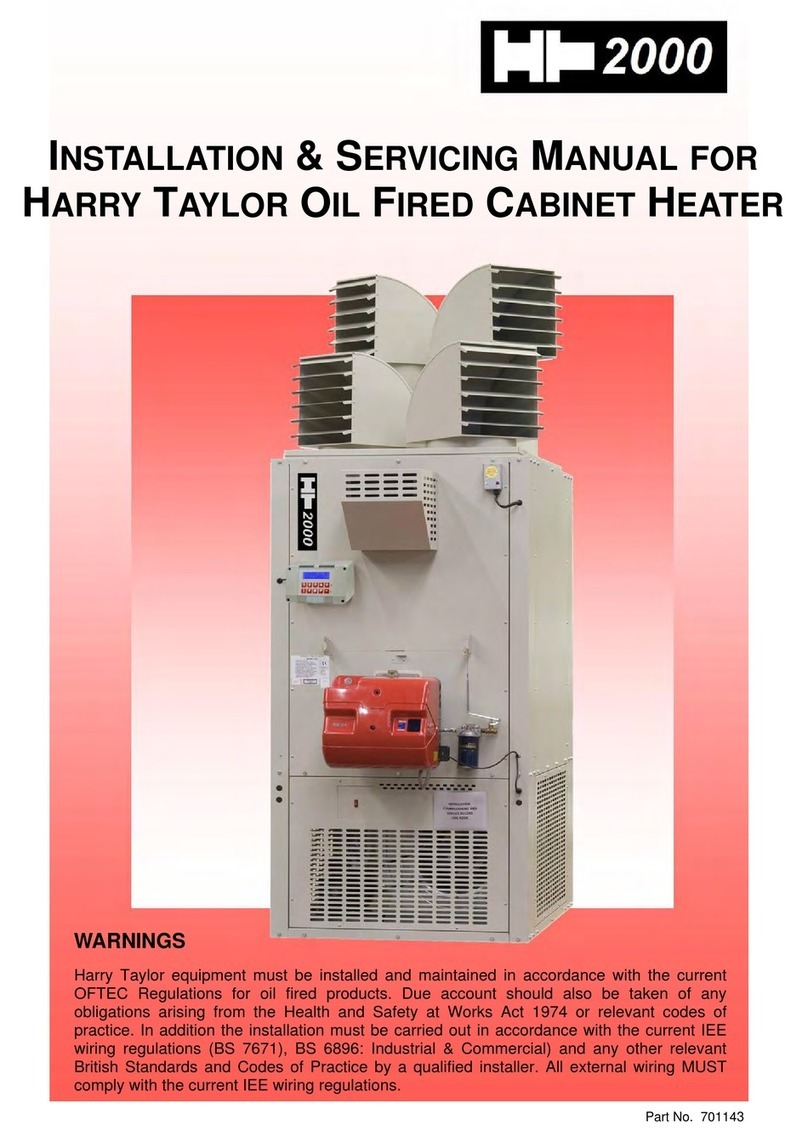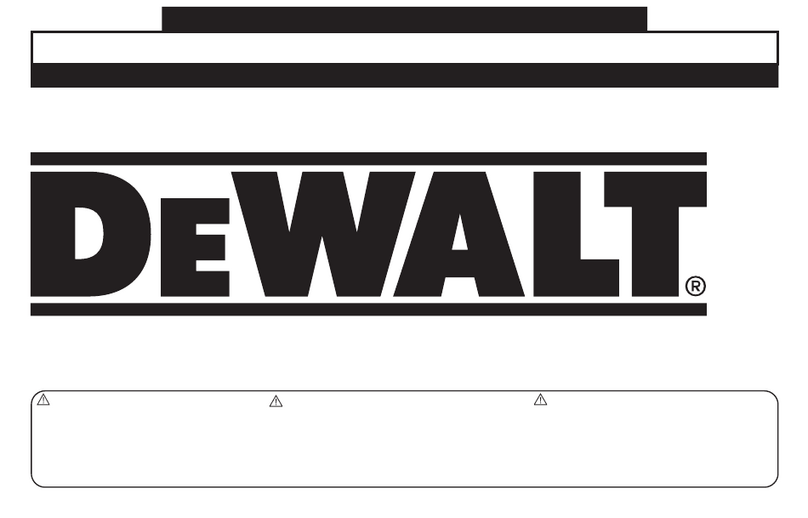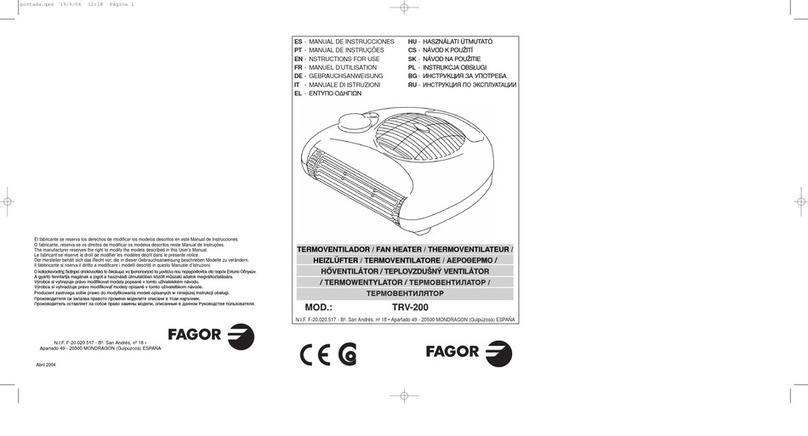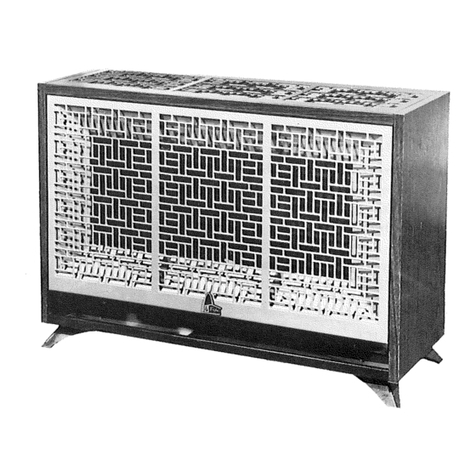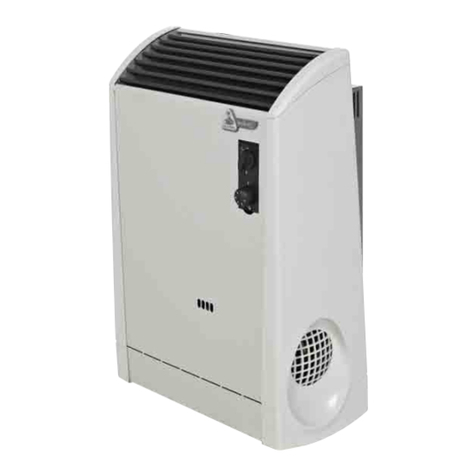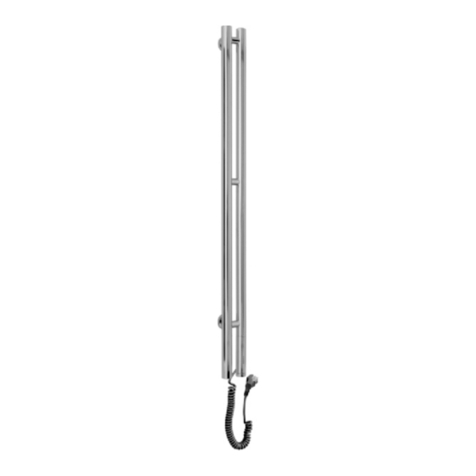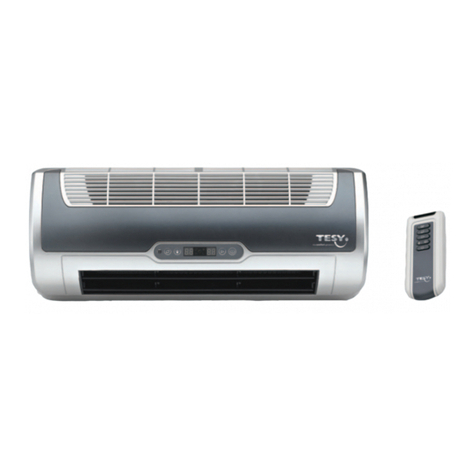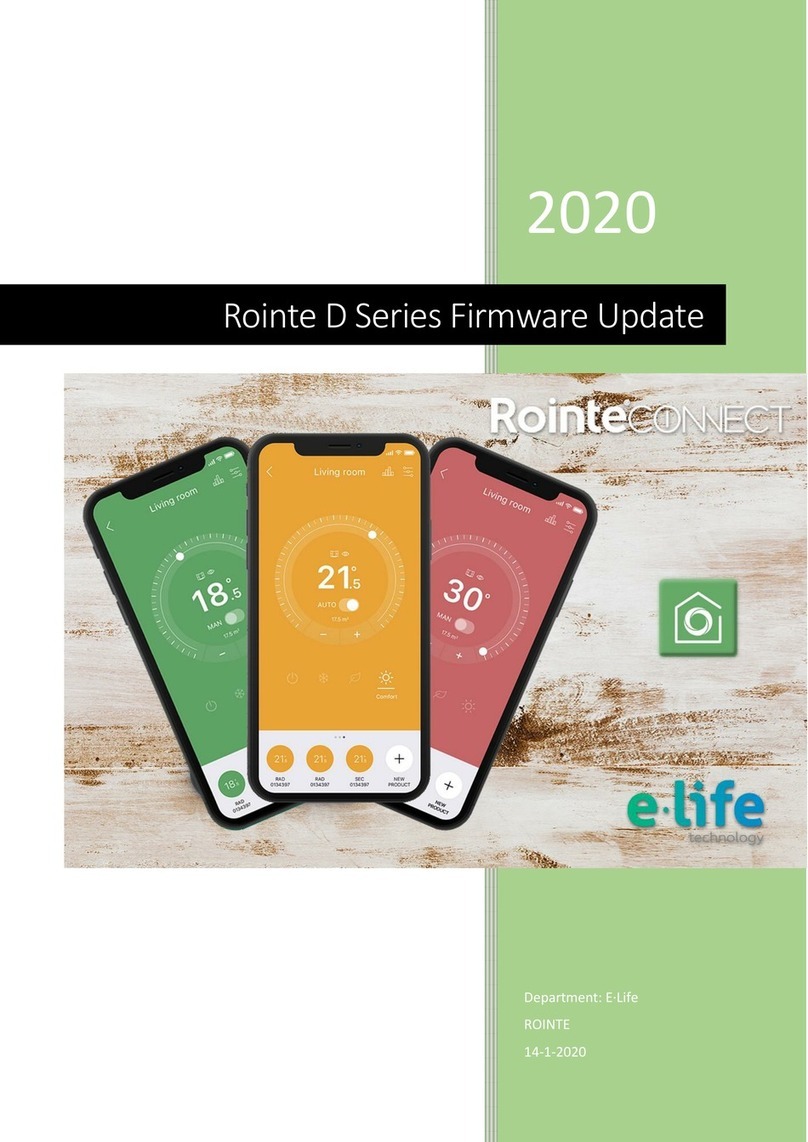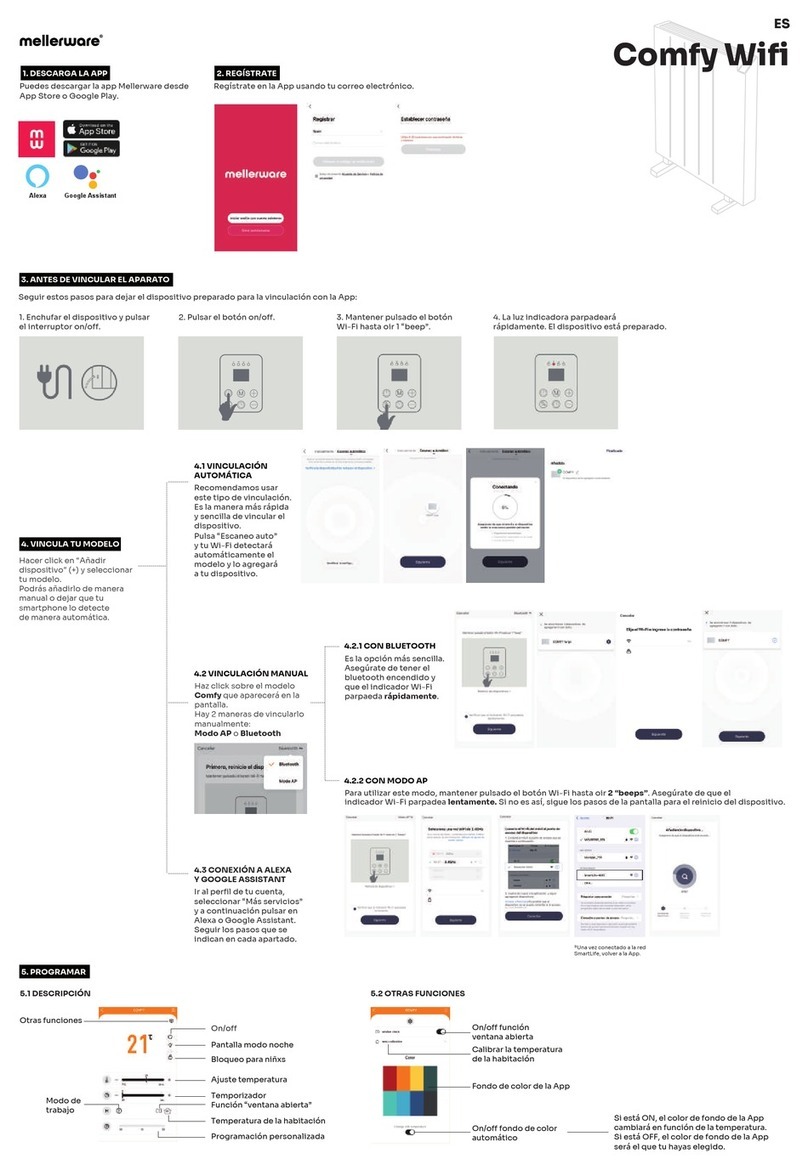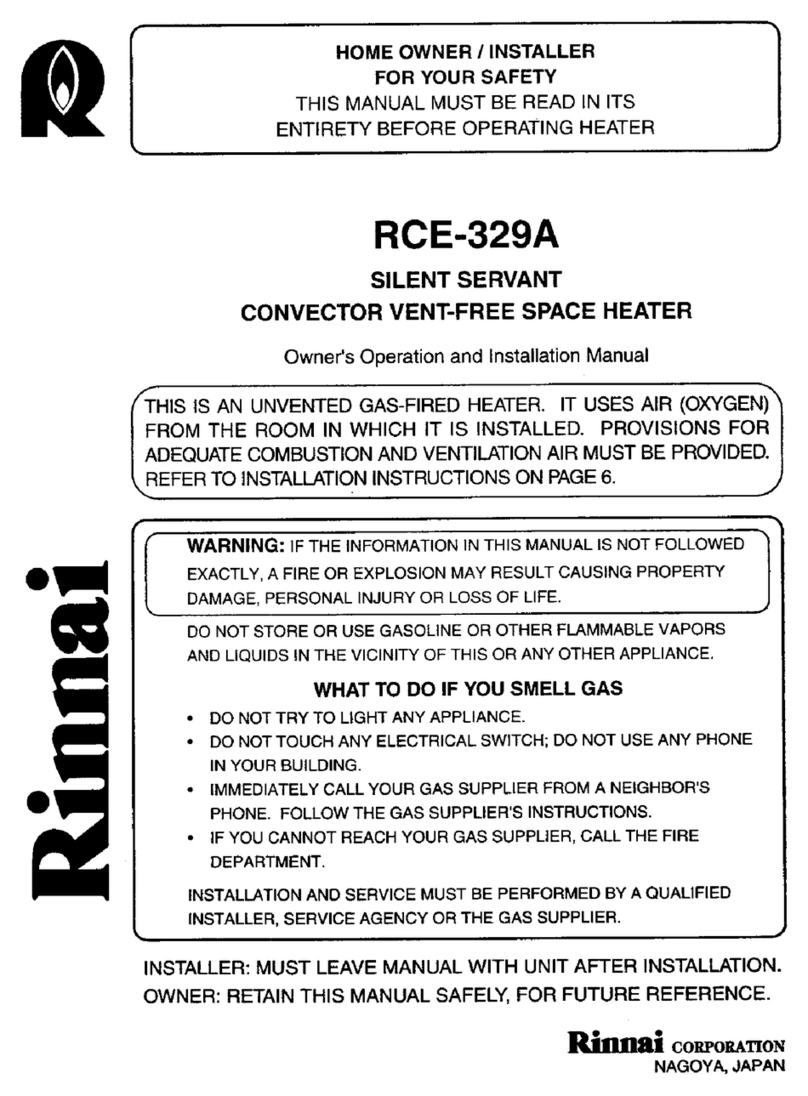Harry Taylor HT2000 User guide

1
WARNINGS
Harry Taylor equipment must be installed and maintained in accordance with the relevant
provisions of the Gas Safety (Installations and Use) Regulations 1998 for gas fired products.
Due account should also be taken of any obligations arising from the Health and Safety at
Works Act 1974 or relevant codes of practice. In addition the installation must be carried out
in accordance with the current IEE wiring regulations (BS 7671), BS 6896 (Industrial &
Commercial) and any other relevant British Standards and Codes of Practice by a qualified
installer. All external wiring MUST comply with the current IEE wiring regulations.
INSTALLATION & SERVICING MANUAL FOR
HARRY TAYLOR GAS FIRED CABINET HEATER
NATURAL GAS (G20 I2H), PROPANE GAS (G31 I3P)
Part No. 701123

2
1 Compliance Notices …………………………………....………..…..…………. 4
1.1 Certificates of Conformity ………………………………..…………..…. 5
1.2 General Product Information …………………………………….…………. 5
1.3 General Requirements ……...……………………………………...………. 5
1.4 Delivery & Pre inspection …………………………………………….…. 6
1.5 Warranty ……………………..…….………………………………………. 6
2 Location & Positioning …………………….………………..…………..…………. 7
2.1 Gas Supply ……………………..……………...………………………. 8
2.2 Electrical Supply ……………...……………………………..………………. 8
2.3 Air Supply ……………………..……………………….……………………. 9
2.4 Minimum Space Requirements ….…………..………………...………. 11
2.5 Air Distribution System…………………………………...……...…………. 12
2.6 Flue System …………………………...………………..….……. 12
2.7 Flue Installation …………………………………………….....……………. 13
3 Installation …………………………………………………...…….…….…………. 16
3.1 Packaging & Siting ………………...……………………...……………. 16
3.2 Flooring …………………………………………………..…….....………. 16
3.3 Minimum Clearances ……………………………………...………………. 16
3.4 Assembly ……………………………………………………………..….…. 16
3.5 Gas Installation & Connection ………………..………….……...……. 16
3.6 Electrical Installation & Connection….……………………..……...………. 17
3.7 Air Distribution Installation ……………………………….………………. 17
3.8 Warm Air Registers ………………………………………..……………. 17
3.9 Heater Control Installation ……………………………….………………. 18
4 Commissioning …………………………………...……………..…….…….……. 19
4.1 Pre test …………………………………………………...…..…..………. 19
4.2 Ignition ……………………………………………………….…..………. 19
4.3 Air Delivery System …………………………………....…...…..….……. 21
4.4 Hand Over …………………………………………………...….…...………. 22
5 Servicing …………………………………………………...…………..…………. 22
5.1 Planned Servicing …………………………………....………..………. 22
5.2 Servicing procedure Major Components ….……………………...………. 23
5.3 Service Re commissioning ….…………………………………...………. 25
6 Fault Diagnosis By Flow Chart ………….………………...…….……...……. 27
7 Wiring Diagrams ……………………………………………………...……………. 29
8 Technical Data …………………………………………………...………………. 42
8.1 Cabinet Range Technical Data …………..…..………………..………. 43
8.2 Reference Documents Standards & Codes of Practice ...……...…… 47
9 Parts Listing …………………………………...………………..……………………. 49
10 User Instructions …………………………………………………………...………. 52
10.1 Commissioning/hand over ……………………………….……….……... 52
10.2 Servicing ……………………………….…………………………..…….… 52
10.3 Start up procedure ……………………………….…………….….……. 52
10.4 Stop procedure ……………………………….……………………………. 52
10.5 Shutdown procedure ……………………………….……………...……... 52
10.6 Ventilation only ……………………………….…………………..….…..... 52
10.7 Lockout situations ……………………………….…...………..………. 52
Contents

3
Illustrations
1 Flue Systems ………………………………………………………...……………. 14
2 Turbulator Positions …………………………………………………….…………. 26
3 Exploded View ……...………………………………………………………………. 48
Any reference made to Laws, Standards, Directives, Codes of Practice or other
recommendations governing the application and installation of heating appliances and
which may be referred to in Brochures, Specifications, Quotations, and Installation,
Operation and Maintenance manuals is done so for information and guidance purposes only
and should only be considered valid at the time of the publication. Harry Taylor of Ashton
Ltd. cannot be held responsible from any matters arising from the revision to or introduction
of new Laws, Standards, Directives, Codes of Practice or other recommendations.
IMPORTANT NOTICE TO INSTALLERS
Installers should satisfy themselves that the gas pipework installation is carried out in
accordance with all current legislation, Codes of Practice and recommendations .
Additionally it may be necessary to protect the gas valves which form part of
the heater or burner assembly from potential pipe contamination particularly,
but not exclusively , where copper gas pipework is used.
In instances where copper pipework is to be used for all or part of a gas
pipework installation, including short length final connections then we advise
that installers consult with gas supplier or provider and satisfy themselves what
additional precautions may be necessary

4
1.0 Compliance notices
The Harry Taylor Gas fired Cabinet Heaters
detailed herewith are manufactured by Harry
Taylor of Ashton Ltd. within a strictly
controlled quality environment within the
parameters of ISO 9001.
These instructions are only valid if the
following country code is on the appliance
GB. IE. If this code is not present on the
appliance, it is necessary to refer to the
technical instructions which will provide the
necessary information concerning the
modification of then appliance to the
conditions of use for the country.
The Harry Taylor range has been tested and
assessed for compliance with the following
European Directives.
Gas Appliance Directive: (90/396/ EEC)
Machinery Directive: (2006/42/EC)
Low Voltage Directive: (2006/95/EC)
Electromagnetic Compatibility Directive:
(2004/108/EC)
Product Liability Directive: (85/374/EEC)
The manufacturer has taken reasonable and
practical steps to ensure that Harry Taylor
Cabinet Heaters are safe and without risk
when properly used. These heaters should
therefore only be used in the manner and
purpose for which they were intended, and
in accordance with the recommendations
detailed herewith.
The heaters have been designed,
manufactured, assembled, inspected, and
tested, with safety and quality in mind, there
are certain basic precautions which the
installer and user should be aware of, and
they are strongly advised to read the
appropriate sections of the information pack
accompanying the heater, prior to
installation or use.
Harry Taylor of Ashton Ltd. supports all new
products being supplied to their customers
with a comprehensive information pack; this
clearly defines mandatory instructions for
the safe installation, use, and maintenance,
of the appliance(s).
Where proprietary items are incorporated
into Harry Taylor of Ashton Ltd. products,
detailed information and instructions are
also provided as part of the information
pack.
It is the responsibility of the installer, owner,
user, or hirer, of such products supplied by
Harry Taylor of Ashton Ltd., to ensure that
they are familiar with the appropriate
information/manuals, supplied by the
manufacturer, and that they are suitably
aware of the purpose of the manuals and
the safety instructions. In addition, operators
must be suitably trained in the use of the
appliance so as to ensure its continued safe
and efficient use.
Harry Taylor of Ashton Ltd. has a
commitment to continuous improvement,
and therefore reserves the right to amend or
change the specification of the Cabinet
Heater range subject to compliance with the
appropriate European, national, and local
regulations.
Contained within the text of the manual, the
words 'Caution' and 'Warning' are used to
highlight certain points.
Caution is used when failure to follow or
implement the instruction (s) can lead to
premature failure or damage to the heater or
its component parts.
Warning is used when failure to heed or
implement the instruction (s) can lead to not
only component damage, but also to a
hazardous situation being created where
there is a risk of personal injury.
The Harry Taylor range of Gas fired Cabinet
Heaters conform to the following
harmonised standards:
BS EN 1020 Requirements for non
domestic gas fired forced convection air
heaters for space heating incorporating a
fan to assist transportation of combustion air
and/or combustion products.
BS EN 292 -1
Safety of Machinery - Basic Concepts,
General Principles for Design Basic
terminology, methodology

5
BS EN 292-2
Safety of Machinery - Basic Concepts,
General Principles for Design
Technical Principles and Specifications
BS EN 60204-1
Safety of Machinery - Electrical Equipment
for Machines Specification for General
Requirements
BS EN 60335-1
Safety of Household and Similar Electrical
Appliances General Requirements
BS EN 55014
Limits and methods of measurement of
radio disturbance characteristics of electrical
motor-operated and thermal appliances for
household and similar purposes, electrical
tools and similar electric apparatus
BS EN 50165
Electrical Equipment of non-electric heating
appliances for household and similar
purposes, safety requirements
1.1 Certificates of conformity
Certificates are available from the Quality
Control Department at Harry Taylor of
Ashton Ltd.
Notified body Pin reference is :
0558CM1312
1.2 General product information
The Harry Taylor range of indirect gas fired
forced convection heaters have an output
range from approximately 29.3 kW to 381.0
kW and are available in a configuration that
will allow for down flow, horizontal, floor
mounting, or above ground level on purpose
built steel supports.
The units can suit either ducted applications,
or be used as free blowing units, but each
heater must be connected to its own
individual open flue.
Each heater is fitted with a forced draught
burner which has been test fired and pre-set
prior to despatch. The safety functions of the
burner are by way of a fully sequential
control box fitted to the burner.
Note
Neither asbestos nor soft soldered joints are
used in the construction or manufacture of
the Harry Taylor range of Cabinet Heaters.
The materials selected for use can
withstand the mechanical, chemical, and
thermal stresses which they will be subject
to during foreseen normal use when
installed in accordance with the
manufacturers recommendations.
1.3 General requirements
Caution
Before installation, check that the local
distribution conditions, nature of gas and
pressure, and the current state adjustment
of the appliance are compatible.
Installation, commissioning, and
servicing must only be carried out by
appropriately qualified and competent
persons.
Warning
Unauthorised modifications to the appliance,
or departure from the manufacturers
guidance on intended use, or, installation
contrary to the manufacturers
recommendations may constitute a hazard.
Note
To ignore the warning and caution notices,
and to ignore the advice from the
manufacturer on installation, commissioning,
servicing, or use, will jeopardise any
applicable warranty, moreover, such a
situation could also compromise the safe
and efficient running of the appliance itself,
and thereby constitute a hazard.
The installation of the appliance must meet
all the relevant European, national, and local
criteria. (See sections 3 and 9).
Prior to installation the following points
should be considered;
a) The position of the heater for the optimum
efficient distribution and circulation of warm
air.
b) The position of the heater relative to the
route of the flue
c) The position of the heater relative to the
supply of gas

6
d) The position of the heater relative to the
electrical services, and if appropriate, any
additional controls.
e) The position of the heater relative to the
supply of fresh air
f) The height if applicable at which the
heater is to be mounted and potential
stratification / circulation problems.
g) The position of the heater relative to
service and maintenance requirements
Caution
The heater must not be installed within an
area where the conditions are unsuitable,
e.g. where the atmosphere is highly
corrosive, has a high degree of salinity, or
where high wind velocities may affect burner
operation. Suitable protection should be
provided for the appliance when it is located
in a position where it may be susceptible to
external mechanical damage from; for
example, fork lift trucks, overhead cranes
etc.
1.4 Delivery and pre-installation
checks.
The heater is supplied wrapped in heavy
duty protective polythene. On receipt of the
heater, the following checks should be
carried out;
a) The model is as per order.
b) That it is undamaged.
c) That it is suitable for the fuel supply.
d) That it is suitable for the electrical supply
If any of these points are not satisfied then
contact should be made with the Sales
Office at Harry Taylor of Ashton Ltd. as soon
as possible by telephoning 0161 3084550.
In the case of claims for damage, this must
be signed for as damaged and reported in
writing within 24 hours of delivery, in order
to comply with insurance criteria.
1.5 Warranty
The heater is supplied with a 1 year parts
and labour warranty and a further year on all
parts excluding consumable’ s.
In addition to this there is also a 10 year
time related warranty on the combustion
chamber.
The warranty commences from the date of
dispatch from the manufacturer, and is
subject to the terms detailed within the Harry
Taylor of Ashton Ltd. 'conditions of
business'.
Note (i)
The warranty may be invalidated if -
a) The installation is not in accordance with
the general requirements of this manual.
b) the heater are not in accordance with the
manufacturers recommendations, codes of
practice, or similar standards.
c) Air flow through the heater is not in
accordance with the manufacturers
technical specifications.
d) Internal wiring on the heater has been
tampered with or unauthorised service or
repairs undertaken.
e) The main electrical supply input to the
heater has been interrupted during the
heating mode.
f) The heater has been subject to and
affected by the ingress of water in any form.
g) The heater is not operated at the rating(s)
laid down in the manufacturers technical
specifications.
h) The heater has not been operated or
used within the normal scope of its intended
application.
i) The manufacturer's recommended
minimum service requirements have not
been complied with:

7
Note (ii)
All warranty claims must contain the
following information to enable processing to
take place;
(1) Heater model
(2) Heater serial number
(3) Order reference/date of order, together
with full installation details (name and
address)
(4) Details or symptoms of fault
(5) Installers name and address.
Faulty parts must be returned to the Harry
Taylor Spares Department, the address of
which is provided at the rear of this manual.
Any such parts will undergo inspection to
verify the claim. Replacement parts supplied
prior to this may be charged, and a credit
supplied upon subsequent validation of the
warranty claim.
Consumable items are specifically not
included within the scope of the warranty.
Note (iii)
Notification is required immediately a fault is
suspected.
The manufacturer will not accept
responsibility for any additional damage that
has been caused, expense incurred, or
consequential loss resulting from any failure
of the heater(s).
2.0 Location / Positioning
Warning
All of the basic criteria must be satisfied
prior to commencing installation and
commissioning, additionally, the Cabinet
Heater must be positioned and installed so
as to comply with all the relevant standards
and guide lines (see section 9.0), as well as
meeting national and local fire regulations
and insurance criteria, especially if it is
proposed that the heater is to be installed
within a special risk area (e.g. proximity to
where petrol engined vehicles are stored or
parked, where cellulose spraying takes
place, where woodworking machinery is
operated, etc,).
Indirect fired heaters must not be located in
hazardous areas, however, it is permissible
for the heater to supply air to such areas.
The heater must not be installed within an
environment where there is a high
concentration of chlorides, fluorides, salts,
or other aggressive or volatile chemicals /
compounds. Nor should the heater be
positioned where the burner could be
adversely affected by high winds or
draughts.
The location chosen for the heater must
allow for the fitting of an effective flue
system.
The location must also allow for adequate
clearance for the air supply, return air
circulation, oil supply, electrical supply,
whilst also providing good and safe working
access. The heater must be installed on a
flat and level surface made from non-
combustible material, which is sufficiently
robust to withstand the weight of the heater
and any ancillary equipment. Any
combustible material adjacent to the heater
or flue system must be so placed or
shielded so that its surface temperature
does not exceed 65°C.
In areas where it is proposed that more than
one heater is to be installed, a general
scheme of circulation should be drawn up
and maintained, thereby offering the best
heat distribution.

8
All Harry Taylor Heaters are fitted with a
pressure relief facility, this is incorporated
into the design of the flue gas exit duct.
Care should therefore be taken in siting
service connections and controls well away
from the pressure relief vent.
Warning
Under no circumstances must the pressure
relief be restricted, blocked, or have the free
exit of exhaust gas impaired or re-directed.
2.1 Gas supply - general.
The Harry Taylor range of gas fired cabinet
heaters are all manufactured and pre-set for
use with natural gas or LPG classified under
the categories, based upon the destination
of the heater see section 8.0
The heater must be compatible with the gas
supply, and each heater must be installed
with a separate approved isolating gas cock
positioned adjacent to and upstream of the
union between the service pipe and the
heater.
The gas supplier should have been
contacted to confirm that the supply feed
(pipework and metering) is capable of
delivering the required dynamic volume of
gas, thereby ensuring that the minimum
burner pressure can be achieved.
Consideration should have also been given
to the pressure drop on single and multiple
heater installations, and the affect that such
installations will have upon other plant
sharing the gas supply.
If it is necessary to fit a gas booster, the
controls must include a low pressure cut-off
switch which must be fitted on the supply
side of the booster. It is also a requirement
that the gas supplier is contacted prior to the
fitting of the unit.
Note
Reference to the Institute of Gas Engineers
publication UP-1 and UP-2 together with
BS6891 is strongly advised.
Service and Installation pipework must be of
a diameter equal to or greater than the inlet
connection on the heater, all joints must be
sealed using an approved sealing
compound, and the system purged and
tested for soundness.
2.2 Electrical supply
Wiring external to the cabinet heater must
be installed in accordance with any local,
national, and European regulations, as well
as meeting the appropriate requirements of
IEE regulations.
The means of connection to the main
electrical supply must allow for complete
electrical isolation of the heater,
furthermore, in the case of a unit wired for a
three phase supply, the supply should only
be used to serve the heater itself and no
other plant or equipment.
The position of the isolation switch must be
such that it is adjacent to the heater and
easily accessible at all times. In addition, the
isolator itself must have a contact separation
of not less than 3mm as per BS5991 clause
20.2. The Control Fuse ratings are detailed
on the appliance data plate.
Warning Ensure that the electric and gas
supplies are turned off before any electrical
work is carried out on the heater. Ensure
that wiring cannot make contact with any
surfaces liable to be subject to high
temperatures or where the insulation of the
wiring could be impaired as a result of such
contact.
All Cabinet Heaters must be earthed.
Caution
The main electrical supply must not be
switched off or disconnected as a method
for stopping the heater, the exception to this
is in an emergency, or during servicing,
when the heat exchanger has been allowed
to cool sufficiently to prevent any damage
from occurring. Claims for damage will not
be considered if they have resulted from
incorrect wiring or the incorrect use of the
heater.

9
2.3 Air supply
Consideration must be given to the provision
of air for the purposes of combustion and
ventilation of the heated space, plant room
or enclosure where heaters are to be
installed.
Note:
It is strongly recommended that BS 6230 :
2005 is referred to for further information
concerning ventilation requirements
Where mechanical ventilation is used it is a
requirement that the inlet is of the
mechanical type, and the outlet is either
mechanical or natural.
2.3.1 Heaters installed within the
heated space.
Where heaters are installed within the space
to be heated (i.e. not a plant room or
enclosure) then:
Combustion air or heater related ventilation
air will not be required if -
The design air change rate of the
heated space is 0.5 air changes per
hour or greater
or
The design air change rate may be
satisfied by natural infiltration or by
mechanical ventilation
Combustion and General ventilation will be
required if -
The design air change rate of the
heated space is less than 0.5 air
changes per hour
or
Where the heated space has an air
change rate of less than 0.5 air
changes per hour then it will be
necessary to provide either natural
ventilation openings to the heated
space (section 2.3.1.1. refers) or the
mechanical ventilation of the heated
space (section 2.3.1.2. refers)
2.3.1.1 Natural Ventilation Openings
to the Heated Space.
If the heated space design air change rate is
less than 0.5 air changes per hour then
provision for low level natural ventilation
openings will only be necessary.
The minimum free area of the low level
natural ventilation opening shall be:
2cm2for each kW of rated heat input
The low level natural ventilation opening
should be situated on an external wall and
be within 1000 mm of floor level for natural
gas and ideally at floor level for l.p.g gas
installations but in any event no higher than
250 mm.
The table below provides specific data for
each heater model as -
2.3.1.2 Mechanical Ventilation to the
Heated Space.
In the event that the heated space has a
design air change of less than 0.5 air
changes per hour and that installer prefers
to mechanically ventilate the heated space
rather than provide ventilation openings then
-
Minimum Free Area of
ventilation opening
High Level Low Level
cm2cm2
30 None 64
35 None 79
40 None 97
60 None 127
75 None 160
85 None 193
120 None 257
135 None 291
180 None 386
205 None 460
235 None 515
275 None 623
350 None 769
375 None 847
Model

10
The heated space needs to be
mechanically ventilated so that the
design air change is 0.5 air changes or
greater.
It is a requirement that the mechanical
ventilation shall be of the ‘input’ type
with either natural or mechanical
extraction.
Systems of mechanical extraction with
a natural inlet shall not be used.
It is necessary to provide an automatic
means to safely inhibit heater(s)
operation should mechanical air
supply fail for any reason.
2.3.2. Heaters Installed within a Plant
Room or Enclosure.
A plant room means a room housing the
heater plant and probably other items of
building service plant and would generally
have generous space for maintenance.
An enclosure is where the heater is installed
within a compartment or confined area
where space is limited.
Where heaters are installed within a plant
room or enclosure then provision for both
combustion air and air for general ventilation
will be required by means of high and low
level ventilation openings (sections 2.3.2.1
refers to plant room applications and
sections 2.3.2.2 refers to enclosure
applications).
Alternatively the plant room or enclosure
may be mechanically ventilated (section
2.3.2.3 refers).
2.3.2.1 Natural Ventilation Openings
to Plant Rooms
For plant room applications the minimum
free area of ventilation opening shall be:
At high level 2 cm2for each kW of
rated heat input.
At low level 4 cm2for each kW of rated
heat input.
The high level ventilation opening should be
sited on an external wall and positioned as
high as is practical and always within the top
15% of the wall height.
The low level natural ventilation opening
should be situated on an external wall and
be within 1000 mm of floor level for natural
gas and ideally at floor level for l.p.g gas
installations but in any event no higher than
250 mm.
The table below provides specific data for
each heater model as -
2.3.2.2 Natural Ventilation Openings
to Enclosures
For enclosure applications the minimum free
area of ventilation opening shall be:
At high level 5 cm2for each kW of
rated heat input.
At low level 10 cm2 for each kW of
rated heat input.
Minimum Free Area of
ventilation opening
High Level Low Level
cm2cm2
30 64 128
35 79 158
40 97 194
60 127 254
75 160 320
85 193 386
120 257 514
135 291 582
180 386 722
205 460 920
235 515 1030
275 623 1246
350 769 1538
375 847 1694
Model

11
The high level ventilation opening should be
sited on an external wall and positioned as
high as is practical and always within the top
15% of the wall height
The low level natural ventilation opening
should be situated on an external wall and
be within 1000 mm of floor level for natural
gas and ideally at floor level for l.p.g gas
installations but in any event no higher than
250 mm.
The table in the next column provides
specific data for each heater model as -
2.3.2.3 Mechanical Ventilation to a
Plant Room or Enclosure.
In the event that the installer prefers to
mechanically ventilate the plant room or
enclosure rather than provide ventilation
openings then -
The plant room or enclosure needs to
be mechanically ventilated at the rate
of 4.14 m3/h of fresh air per kW or
rated heat input.
It is a requirement that the mechanical
ventilation shall be of the ’input’ type
with either natural or mechanical
extraction. Where mechanical
extraction is selected then the
extraction rate should be 5%-10% less
than the input rate.
Systems of mechanical extraction with
a natural inlet shall not be used
It is necessary to provide an automatic
means to safely inhibit heater(s)
operation should mechanical air
supply fail for any reason
The table below provides specific data for
each heater model as -
2.4 Minimum space requirements
The minimum space requirements for single
and multiple heater applications are detailed
in section 3.3 later within this manual.
Minimum Free Area of
ventilation opening
High Level Low Level
cm2cm2
30 159 318
35 198 396
40 244 488
60 317 634
75 400 800
85 483 966
120 643 1286
135 726 1452
180 965 1930
205 1152 2304
235 1287 2574
275 1558 3116
350 1922 3844
375 2118 4236
Model
MODEL Mechanical
Ventilation Rate for
Plant Room or
Enclosure
35 164
40 202
60 262
75 331
85 400
120 533
135 601
180 799
205 954
235 1066
275 1290
350 1592
375 1753
30 132
M3/h

12
2.5 Air distribution system
All materials used within the construction of
the delivery and return air ducts must not
represent a fire hazard and should be made
from thermally inert materials. The selection
of materials must take account of the
environment into which the heater and its air
delivery system is expected to work, it must
also take account of the stresses and
loadings placed upon it during its normal
working life Where interjoist spaces are
used to route ducting these must be lined
with fire resistant insulation material.
In installations where forced recirculation is
a feature, a full and unobstructed return air
path to the heater(s) must be provided, with
return air grilles connected by ducting
directly to the return air inlet on the heater.
The limit for recirculation should not be
greater than 85% recirculated air to 15%
fresh air.
Where the heater is installed within a
enclosure or plant room the return air and
discharge air arrangement must be such
that the air circulation fan does not interfere
with the operation of the flue. The return air
intake and warm air outlet should therefore
be fully ducted to and from the heater,
respectively, within the compartment or
plant room.
If the inlet air is ducted to the outside, then
the lowest edge of the inlet air duct must be
at least 500 mm above the outside floor or
ground level, it must also be fitted with an
access point (s) to allow for cleaning and
servicing to occur. The openings in the
structure of the plant room, through which
the ductwork passes must be of fire
resistant material and constructed to prevent
the likelihood of any fire from spreading.
In ducted applications the ductwork must be
designed so as to give a static pressure
within the limits stated in section 8 of this
manual. It should be noted that if the static
pressure is too high, nuisance shut-down
will occur when the heater goes out on the
overheat limit thermostat, if the static
pressure is too low, then damage can be
caused to the fan motor.
Warm air outlets on ducted applications
must be such that they cannot be closed or
become blocked, which again would lead to
an increase in static pressure and nuisance
shutdown.
The outlets must not be sited so that warm
air can be discharged onto combustible
materials, if necessary, guard rails should
be used to ensure that effected areas are
kept clear. Return air intakes must not be
located so that potentially harmful or
hazardous contaminated air can be drawn
into the system.
2.6 Flue system.
It is essential that the products of
combustion are flued to the outside of the
building. Each heater must have its own
separate flue, with a flue diameter of not
less than is detailed in section 8 within this
manual.
The minimum vertical length of flue must not
be less than 3m. The flue should rise
vertically, and the number of bends should
be kept to a minimum.
Flue pipe should be supported at intervals
not exceeding 1.8mtrs
Flue pipes below a height of 2 m should
be guarded against the possibility of
being accidentally touched when hot by
personnel
It is strongly advised that BS 5854; 1980,
and BS 5440; parts 1 and 2, are used as
consultative documents when considering
flue requirements.
Care should be taken to ensure that the flue
terminal is not situated in a high pressure
area, the proximity of buildings and other
obstacles which will influence this must be
taken into account, preferably at the design
stage. See figures 2-12.
Provision must be made for the
disconnection of the flue for inspection and
service requirements, and it is strongly
advised that where bends are fitted

13
inspection covers are included. The
materials from which the flue is constructed
must be non-combustible, resistant to
internal and external corrosion, and be
capable of withstanding the stresses and
loadings associated with normal use.
When designing the flue system the
prevention of the formation and entrapment
of condensation must be a key
consideration.
Twin wall or insulated systems are
recommended as they tend to inhibit the
formation of condensates.
Where condensation is unavoidable traps
should be included to encourage the
condensates to flow freely to a point from
which they may be released, preferably into
a gully. The condensate pipe from the flue to
the disposal point must be made from
corrosion resistant pipe of not less than
25mm internal diameter.
If the flue passes through a wall, ceiling, or
roof made from combustible material then it
has to be sleeved so as to provide a
minimum of a 25 mm void between the
exterior of the flue and the internal wall of
the sleeve. The maximum permitted
temperature of any adjacent combustible
material is 65oC.
The position of the flue and its terminal
should be such that it does not impair the
combustion process.
It should terminate in an exposed position
so as to allow the escape and dissipation of
flue gases without risk of their re-entering
the property through windows, ventilation
ports, etc,.
The flue should extend to at least 1m above
the height of any object within 3,5m of the
terminal.
Flue terminals should be fitted on all flues
with a diameter of 200 mm or less. The
terminal must be of the approved type, and
have outlet grilles on all sides giving a total
free area of at least double that of the flue.
Caution
It is imperative that the flue should be
properly sealed where it passes through the
roof, this can best be achieved by using the
approved method of roof flashing plate and
cravat.
Note
It should be noted that claims made under
warranty and attributed to the ingress of
water may not be considered especially if an
approved method of sealing has not been
used, or if the design of the flue has not
made provision for possible condensation
problems.
2.7 Flue Installation
An integral flue spigot is fitted to all Cabinet
Heaters thereby allowing the flue to connect
directly to the heater. The design of the flue
must ensure that it can be disconnected to
allow for cleaning and servicing,
furthermore, all of the flue section joint
sockets must face upwards, and the seal
between the sections achieved through
mechanical joints or through the use of
approved caulking string and grout. It is
strongly advised that BS 5854 and BS 5440
parts 1 and 2 are referred to, see also figs 2-
12.
Where condensation is likely to be a
problem provision should be made
preferably at the design stage (see section
2.5).

14
Not less than
600mm
Not less than
600mm
Greater than 1500mm
Parapet
Not less than
600mm
Less than 10 h
Greater than 1500m
m
H1
H2
2
Less than 10 h
1
Flat roof with parapet
Flat roof envelope method
Structure
Not less th an
250mm
Grea te r t han 1 0 h
2
Greater than 10 h
1
H1
H2
Struc tu re
Flat roof where the flue height is more than 10 Heights (H) away from all structures
Struc ture
Not less than
600mm
Less than 1500mm
Flat roof with flue close to parapet

15
Not less than
600mm
Less than
1500mm
Structure
Flat roof with structure close to flue outlet
Pitched roof not greater than 45°
Not less th an
600mm
Not g reater th an
45
°
Not less th an
600mm
Not less than
600mm
Not less th an
250mm
Flat roof with no parapet

16
It is strongly advised that the installer reads
Section 2 and Section 3 of this manual prior
to starting any installation work. It is a
requirement that only qualified and
competent personnel may undertake
installation, commissioning, and servicing.
Warning
Always ensure that the appropriate personal
protective equipment is used.
3.1 Packaging/siting
The heater will usually be supplied wrapped
in polythene, non assembled parts will be
supplied separately. Prior to installation, the
assembly of the heater should be
completed, it is advisable that this is
undertaken in the area where the heater is
scheduled to be sited.
Caution
It is strongly advised that when positioning
the heater the lifting eyes are used, thereby
reducing the risk of inadvertent damage
being occasioned to the heater.
3.2 Flooring
The heater must be installed on a level non
combustible surface capable of supporting
the weight of the heater and any ancillary
equipment.
3.3 Minimum clearances
The following minimum clearances must be
observed when installing the heater (mm).
3.4 Assembly
The following sub-assembly parts should be
assembled to allow installation to continue.
(a) Vertical Nozzled Models
For free blowing applications it will be
necessary to complete the final assembly
before continuing with the installation. The
bonnet top with nozzle spigots should be
attached to the heater and secured. The
nozzles should then be pushed home on the
spigots and positioned to provide the
desired airflow.
Ensure louvres are adjusted outwards
and ensure blades are not resonating.
The nozzles should be securely fixed in their
desired position on completion of
commissioning.
(b) Horizontal Nozzled Models
Remove packaging and secure the 90°Duct
Outlet to the outlet on the heater using the
bolts supplied.
Secure the nozzle spigot plate to the duct
outlet using the bolts and prevailing torque
nuts provided. Fit the securing brackets to
each of the outlet nozzles, and lift the
complete heater assembly and position on
the pre-sited purpose built supports. Finish
off the assembly by fitting and securing the
outlet nozzles to the spigots by way of
previously fitted brackets.
3.5 Gas Installation/Connection
Service pipework must terminate at an
approved gas cock, and be adjacent to the
position of the heater.
The connection to the heater can be made
by way of either an approved flexible
coupling, or rigid connection. Threaded
connections must comply with ISO288/1 of
ISO 7/1, further information concerning the
accepted practice in European countries is
detailed in the June 1995 version of prEN
1020 annex A7 The diameter of the
Model Size Front Rear Lhs Rhs
30 - 40 500 700 150 150
60 - 85 500 1,000 150 150
120 - 135 600 1,200 150 150
180 600 1,500 150 150
205 900 1,500 150 150
230 - 275 900 2,000 400 400
350 - 375 900 2,000 500 500
3.0 Installation

17
pipework from the cock to the burner
connection must not be less than the
diameter of the burner connection inlet. (see
section 8 )
The installation must be purged and tested
for soundness prior to commissioning.
Always ensure that the appropriate personal
protective equipment is used.
3.6 Electrical Installation/Connection
Harry Taylor cabinet heaters are available
either for 415V 50Hz 3PH or 230V 50Hz
1PH supplies depending upon the model
specified.
It is recommended that reference is made to
the wiring diagrams contained within section
7 of this manual prior to installation or
connection to the supply.
The electrical supply must be as specified
and suitable for the heater, and must be run
within conduit to a point adjacent to the
heater, and be terminated to provide an
isolation point that will prevent remote or
inadvertent activation. Cables, conduit, and
fittings that are used to make the connection
between the isolator and the heater must
conform to the appropriate IEE regulations.
All heaters are supplied fused and pre
-wired, all must be earthed.
Final connections for any additional external
controls must be completed on site, and
must be carried out according to IEE
regulations. Separate user information is
provided for the time control unit and the
burner, and forms part of the product
information pack which accompanies every
heater when despatched.
Warning
Always isolate from mains electrical supply
before commencing work on the heater.
Always ensure that the appropriate personal
protective equipment is used.
3.7 Air Distribution Installation
The materials selected must be of low heat
capacity, and it is preferable that all warm
air ductwork is thermally insulated.
Where ducting may be subject to
deterioration from exposure to moisture or
high humidity material selection and
insulation are prime considerations.
Joints and seams must be airtight and
fastened securely and designed to remain
so, even when operating at high
temperatures. Adequate support must be
designed into the layout of the ductwork to
ensure that the integrity of the seams and
joints is maintained.
The support must be independent and
separate from the heater and the ducting, to
allow for free movement during expansion
and contraction.
Where ducting passes through walls or
partitions sufficient clearance must be left,
irrespective of any fire stop requirement, to
allow for expansion and contraction Failure
to adhere to these latter two points can
result in the generation and transmission of
excess noise.
Where ducting is installed in concrete
flooring a permanent membrane must be
used to isolate the ducting from the
corrosive effect of the alkaline salts within
the concrete. Care should be taken to
ensure that soft insulation material does not
become compressed and thereby lose its
effectiveness.
3.8 Warm Air Registers
In order that vertical temperature gradients
are minimal thereby providing a more even
heat distribution, it is preferable to install
warm air registers at low wall levels or at
floor level, with the size, number, and
position commensurate with the requirement
of the application.
To minimise noise levels the registers
should be set away from corners,

18
additionally, a good seal between the
register frame and the wall is important,
particularly on high level positions, if
unsightly staining through warm air/
particulate deposition is to be avoided.
3.9 Heater Control Installation
Warning
Isolate heater from mains before
undertaking any electrical work.
Unless specified all Cabinet Heaters are
manufactured and supplied with a pre-wired
Control panel as standard. Optional remote
controllers are available to be wired back to
the cabinet heater.
Refer to Controller instruction manual for full
installation details.
A commissioning switch is provided on all
cabinet heaters fitted with a remote
controller.
See section 7.0 for individual wiring
diagrams.
The controls for Horizontal Cabinets and
Reverse Flow are supplied as remote option
as standard.

19
Note:
It is a requirement that only suitably
qualified and competent personnel are
allowed to undertake the commissioning
of the heater.
It is also strongly recommended that
prior to commissioning the engineer
familiarises himself with; the information
contained within the information pack
that accompanies the heater, the heater
itself, and with the specific requirements
of the installation /application.
Warning
All Cabinet Heaters undergo a rigorous test
programme prior to being despatched, whilst
such a programme does involve pre-
commissioning and setting up the heater to
operate efficiently and well within its
designed operational limits, this does not
mean that on site commissioning is less
important than might otherwise be the case.
Note
It is strongly recommended that equipment
used for the sampling and analysis of flue
gases is accurate to within +/- 0.1% and
maintained so that it is regularly calibrated.
4.1 Commissioning - Pretest
Check to ensure electrical safety, and
inspect and check the installation, testing for
leaks.
(a) Ensure that the electrical supply is
turned off.
(b) Ensure that the gas supply is turned off.
(c) Check that all panels and fasteners are
secure and in place.
(d) Check that the heater is installed so that
it is square and that the support is adequate.
(e) Ensure that warm air delivery outlets are
open and that ducting is adequately
supported.
(f) Ensure that if filter assemblies are fitted
that they are secure and correctly located.
(g) Check that air inlets are clear and that
return air paths are adequate.
(h) Ensure that the flue is secure,
adequately supported, and that the various
joints are properly sealed.
(i) Check that condensate trap and drain
facilities are adequate.
(j) Check that there is provision for flue gas
sampling and that this sample point can be
plugged and sealed after commissioning.
(k) Check that fan and limit stat settings
have not been disturbed.
(l) Remove lower panel and check motor
and fan drive system for integrity of joints,
check pulley alignment, fan rotation, and
belt tension (see sect 5.2 and figs 17 & 18).
(m) Ensure that the burner is securely
attached to the heater.
(n) Test for electrical earth continuity
between the heater, oil pipe work, and
mains supply.
(o) Turn on main electrical supply.
(p) Enable fan on via controller by selecting
‘Fan only’; ‘Vent only’; ‘Vent/Manual’.*
(* dependent on control type supplied. Refer
to individual controller operating manual.)
(q) Check to ensure burner is off but power
remains to the fan. The fan will start
enabling fan direction etc to be verified.
Reset Fan on/standby switch to off.
(r) Set room thermostat and time clock to
'demand' positions.
(s) Turn mains electrical supply to off,
replace and secure lower louvered panel
covering fan and motor assembly.
4.2 Commissioning - Ignition
Warning
Do not proceed with commissioning unless
all the criteria detailed within sections 4.0
and 4.1 have been satisfied.
(a) Ensure the electrical supply is turned off.
(b) Ensure that the gas supply is turned off.
(c) Turn on main electrical supply.
(d) Enable burner via controller by selecting
‘Heat’ (Relay 2); ‘Heat On’; ‘Heat/Auto’. *
(* dependent on control type supplied. Refer
to individual controller operating manual.)
(e) Select 'on' position for heater on/standby
switch.
(f) Check for the following burner sequence
4.0 Commissioning

20
Interval Operation
1 <5s Combustion air damper actuated,
burner fan motor initiates purge
cycle...
2 <40s Pilot valve opens ignition
transformer provides spark for
pilot ignition...
-------- E I T H E R --------
3 >40s Ignition failure caused by gas
starvation resulting in burner lock
-out/shut-down...
(g) Clear burner lockout using burner reset
function.
(h) Set heater on/standby switch to standby
position
(i) Open gas supply cocks Repeat steps 4.1
q, and 4.2 c,e,f.
----------- O R ----------
3 >40s Pilot ignition... Burner ignition...
4 <60s Burner ignition cycle complete
Note
It is strongly recommended that the separate
manual concerning the operational details of
the burner supplied with the heater as part of
the information package is studied prior to
commissioning. Time intervals within the
ignition sequence will vary slightly from one
model to another.
Warning
If burner ignition is not satisfactorily
accomplished, commissioning must not
proceed until the reason or fault has been
identified and rectified, if necessary by
reference to the separate burner information
or to section 6 of this manual.
(j) Repeat steps 4.2 c,a,
(k) Re-check all connections and joints for
gas soundness using an approved leak
detection fluid.
(l) Remove burner cover and attach
manometers to check burner pressure
settings.
(m) Repeat steps 4.2 d,e,f, allowing the
heater to reach thermal equilibrium.
(n) Check burner pressure settings are in line
with the data as per section 8.1 (if
adjustment is necessary refer to separate
burner information within section B)
Note (i)
The figures quoted in section B are
independent test figures based upon zero
flue resistance.
On completion mark the gas valve
adjustment screw with paint/sealant to
prevent tampering with valve
(o) Adjust room thermostat to its highest
setting, and allow the heater to continue to
fire.
(p) Gradually reduce the temperature setting
on the room thermostat until the burner shuts
down, (@ < ambient) and then gradually
increase the temperature setting on the
thermostat until heat is called for,
(@ > ambient) and the burner automatically
re-fires.
(q) Re-set time clock to a minimum off
period, checking that the burner shuts down,
and then automatically re-lights once the
minimum off period has elapsed (Separate
information on the time clock is contained
within the information package supplied with
the heater).
(r) Check fan and limit stat by depressing
and holding in the fan motor overload re-set
button, located on the heater electrical panel.
The time between the fan stopping and
burner shut down should be noted, once the
burner has shut down the overload on the
motor should be released.
On completion delete any override settings
on optimised control and return temperature
settings to customer requirements.
(s) Undertake flue gas analysis using
approved and calibrated analysing
equipment recording data on the
commissioning card, ie, CO, CO2, net and
gross flue temperatures. Record mains gas,
and burner head pressure, ambient
temperature, barometric pressure, and
complete percentage efficiency calculation
using the formula detailed in section 8.
Note (ii)
The burner air and gas pressure settings
should be only very finely adjusted to
achieve a CO2 reading of 9.3% (+/- 0.1%).
Other manuals for HT2000
5
Table of contents
Other Harry Taylor Heater manuals
Popular Heater manuals by other brands
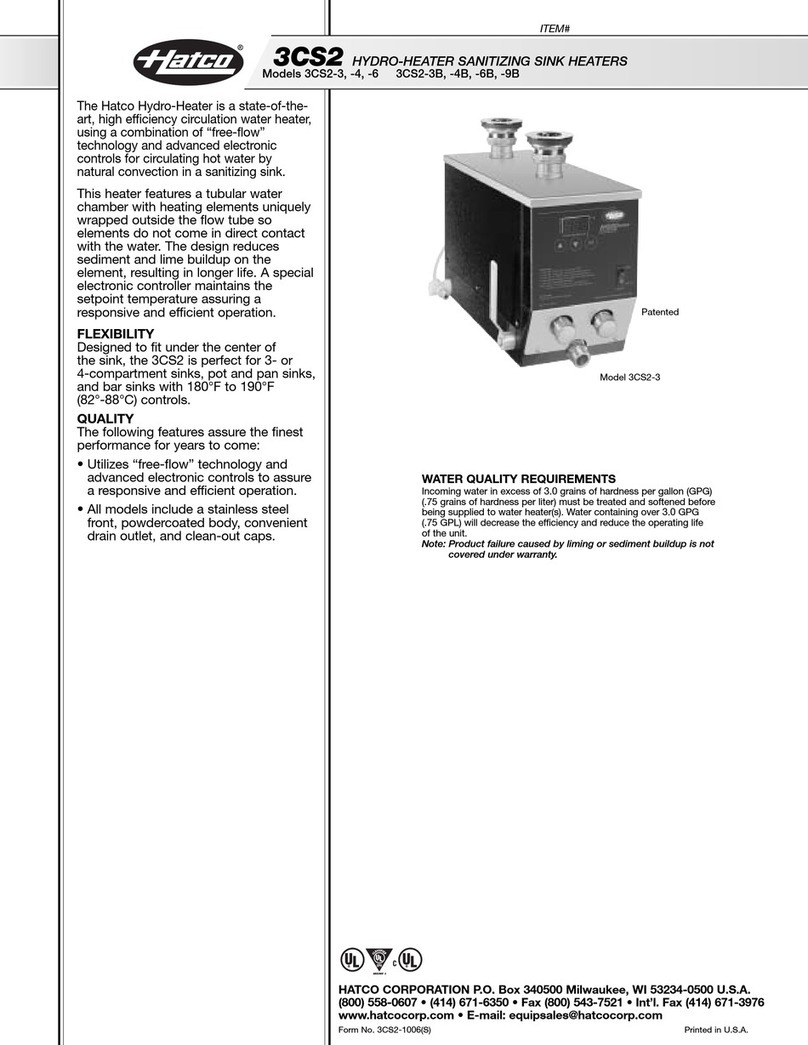
Hatco
Hatco HYDRO-HEATER 3CS2-3 Specifications
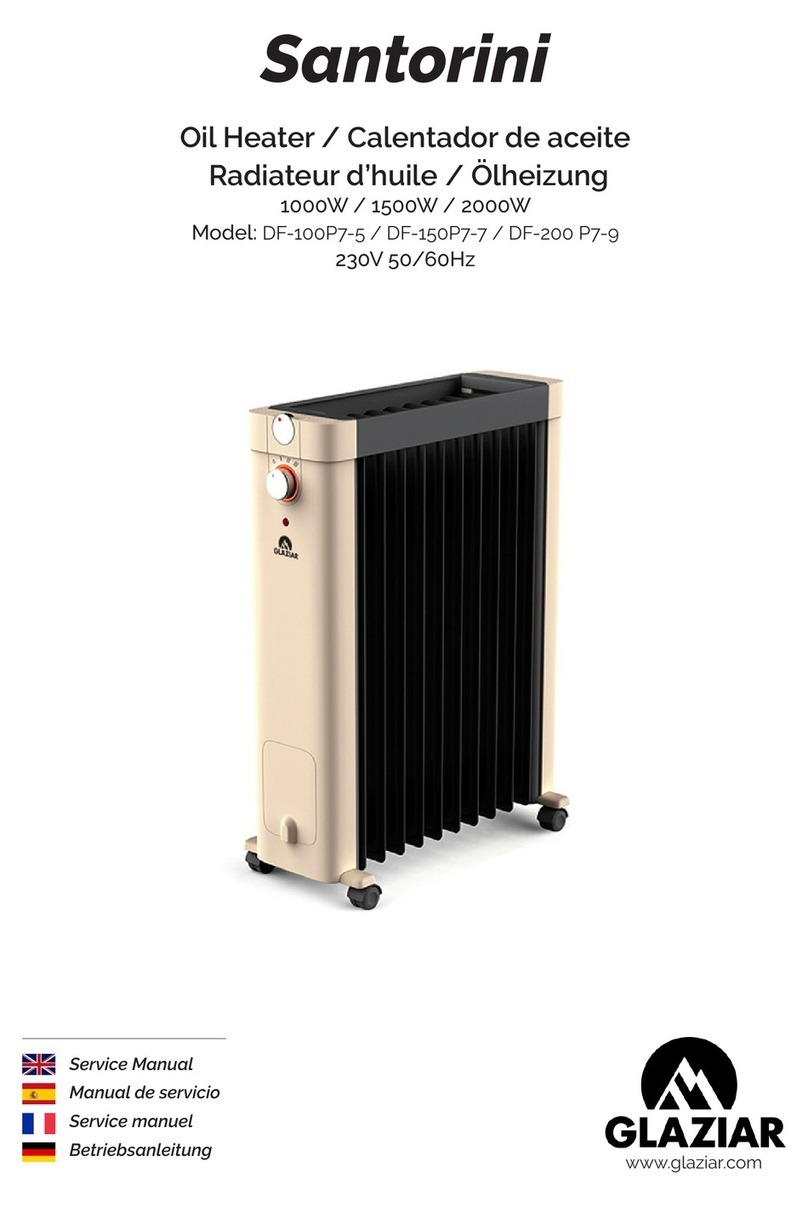
Glaziar
Glaziar SANTORINI DF-100P7-5 Service manual
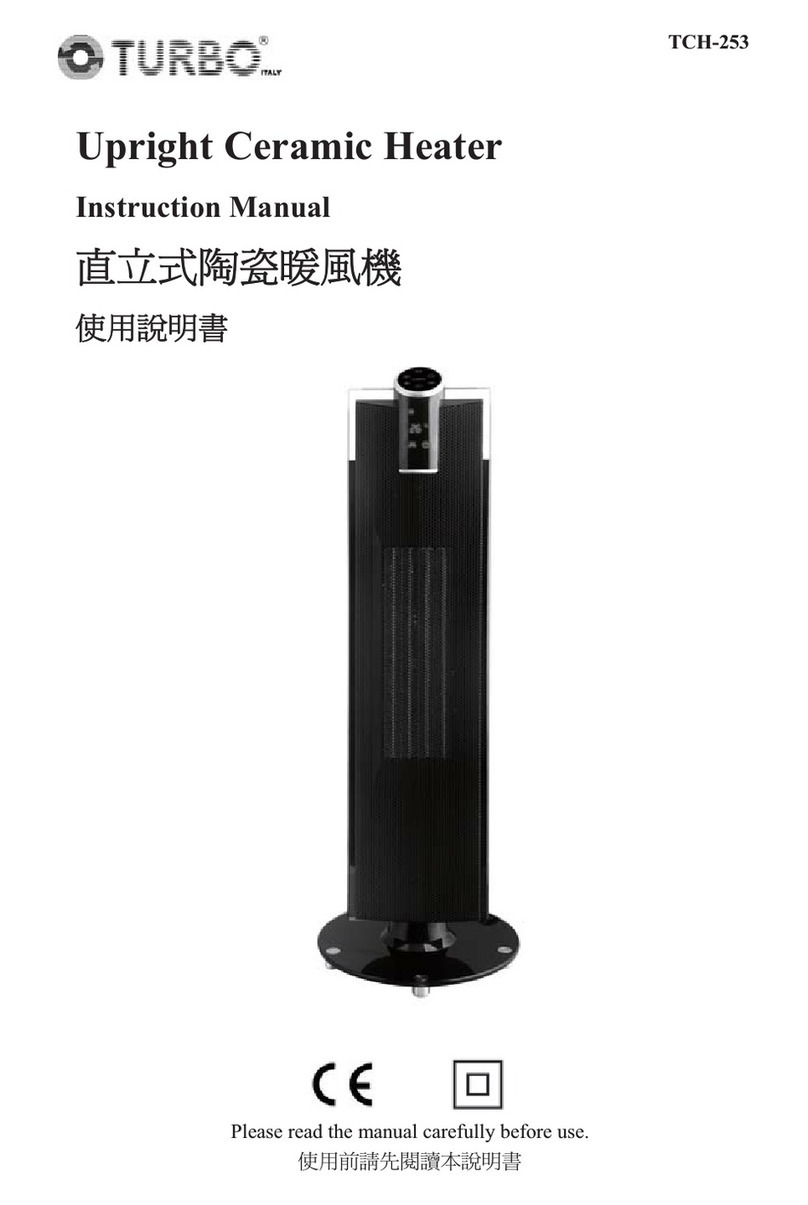
Turbo
Turbo TCH-253 instruction manual
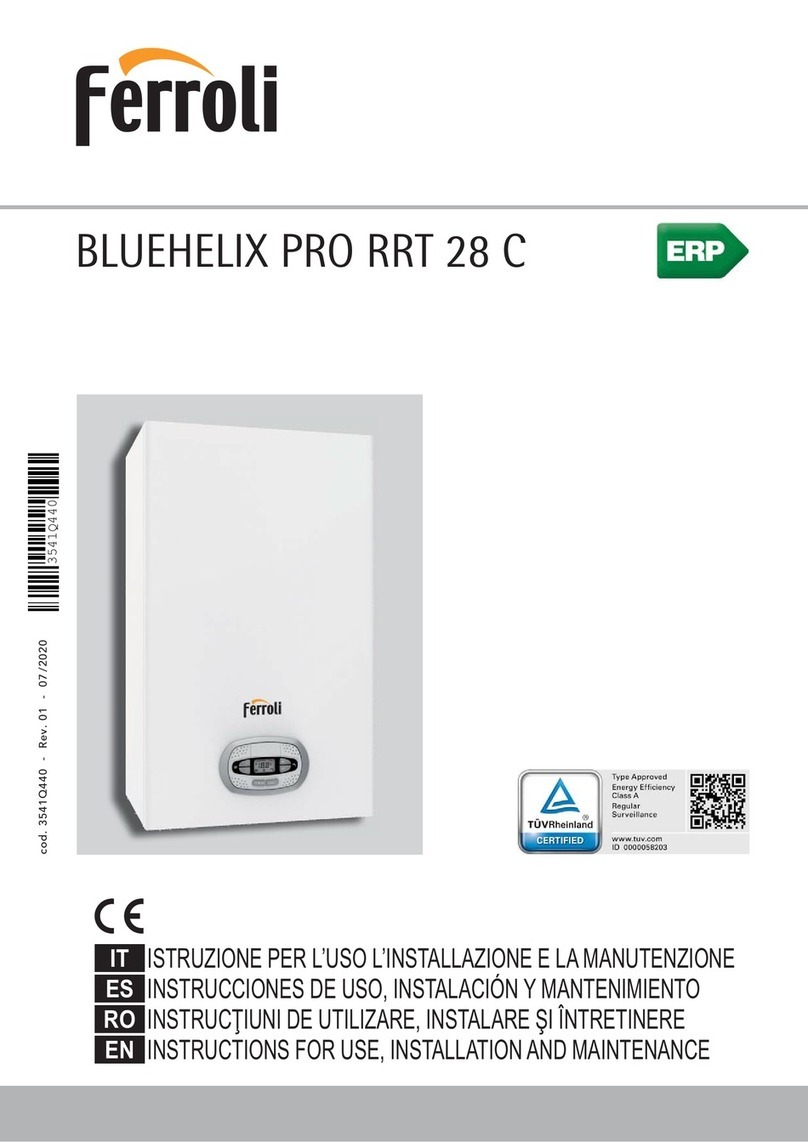
Ferroli
Ferroli BLUEHELIX 352 RRT 28 C Instructions for use & installation
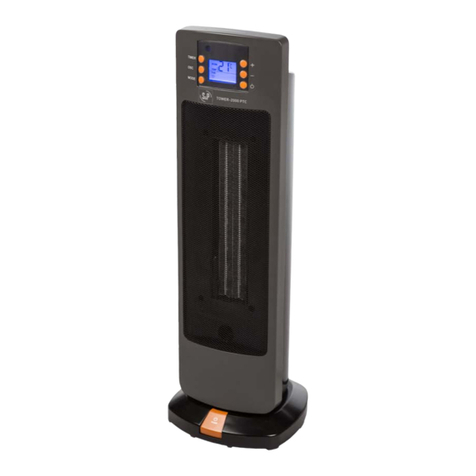
S&P
S&P TOWER-2000 PTC Installation manual and operating instructions
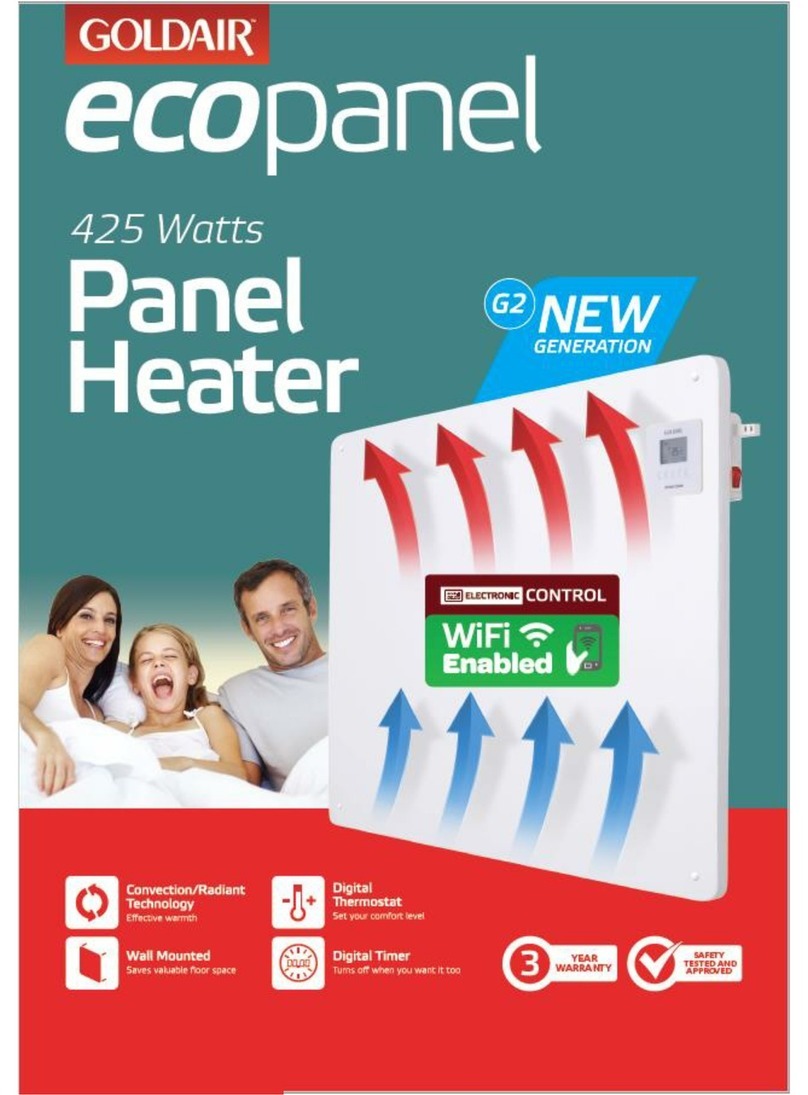
Goldair
Goldair ecopanel GEPH215 manual



